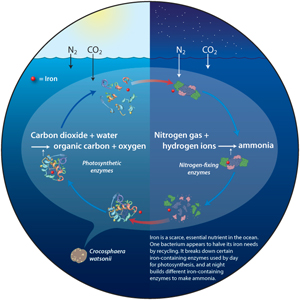`Hot-Bunking' Bacterium Recycles Iron to Boost Ocean Metabolism
`Hot-Bunking' Bacterium Recycles Iron to Boost Ocean Metabolism
 Iron is an essential nutrient for living things, but is scarce in the ocean. Together WHOI and PAOC Scientists have found that a key marine bacterium, Crocosphaera watsonii, may have evolved a remarkable biochemical way to recycle iron for dual metabolic activities.
Iron is an essential nutrient for living things, but is scarce in the ocean. Together WHOI and PAOC Scientists have found that a key marine bacterium, Crocosphaera watsonii, may have evolved a remarkable biochemical way to recycle iron for dual metabolic activities.The organism needs iron for two types of molecule: One is the enzyme nitrogenase which helps break the triple bond of N2 gas to get usable nitrogen (they are nitrogen fixers). The other is in light harvesting machinery. These organisms cleverly swap the iron between light harvesting machinery in the daytime and nitrogenase at night - rather like the practice of so-called "hot-bunking" aboard ships where there are more sailors than bunks and a single bunk may be shared by two people, each working a different shift. Mak Saito and colleagues (also cleverly!) used "proteomics" techniques to demonstrate the change in abundances of nitrogenase and light harvesting machinery over the daily cycle. In parallel PAOC researchers showed how this iron saving might extend the range of habitats over which the organisms could live.
Read more about this research into oceanic iron cycling bringing together the laboratory work of Joint Program graduate student Erin Bertrand (advisor Mak Saito at WHOI), and numerical modeling involving Darwin Project researchers Stephanie Dutkiewicz, Fanny Monteiro and Mick Follows in this WHOI News Office release.
The online version of the Saito et al paper is available here.